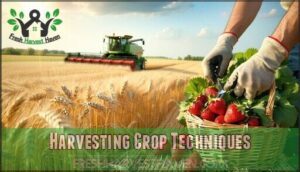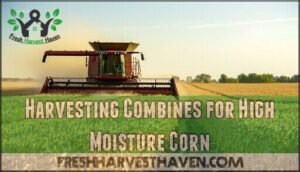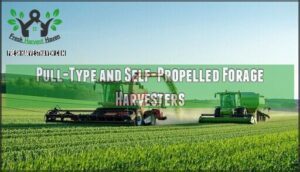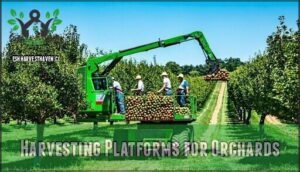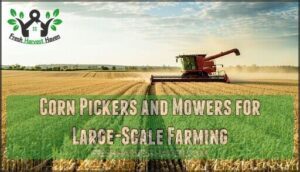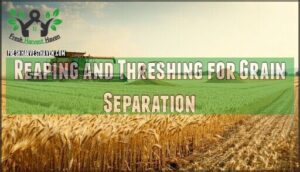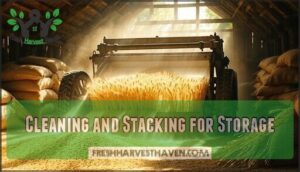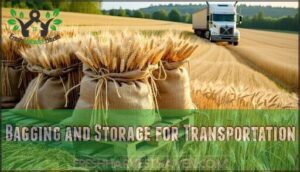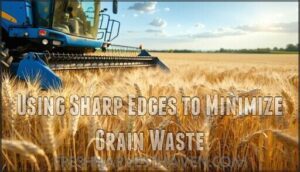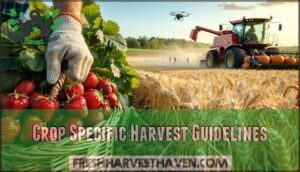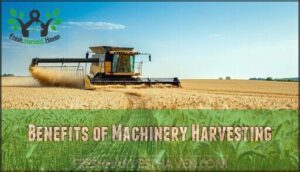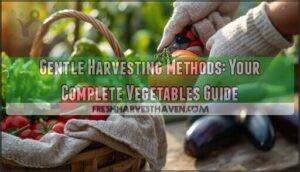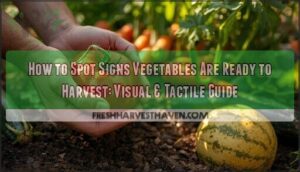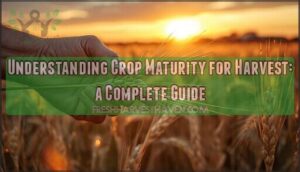This site is supported by our readers. We may earn a commission, at no cost to you, if you purchase through links.
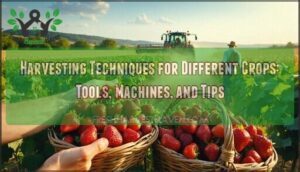
Small tools—like clippers—work wonders for fruits like grapes. On big farms, machinery steals the show: combines handle wheat, while mowers or corn pickers tackle grains and fodder.
Timing is key—too early or late, and your yield suffers. And don’t forget to clean and store your crops right to prevent spoilage. From hand tools to high-tech machines, the right method can be the difference between a bumper crop and a flop!
Table Of Contents
- Key Takeaways
- Harvesting Crop Techniques
- Machinery and Equipment Types
- Harvesting Process Stages
- Crop Specific Harvest Guidelines
- Benefits of Machinery Harvesting
- Frequently Asked Questions (FAQs)
- What are the different methods of harvesting crops?
- How are some crops harvested?
- How and when do we harvest the different kinds of vegetables?
- What are the primary methods of handling fruits and vegetables during harvesting?
- How to harvest different types of crops?
- What are the different harvesting methods?
- What are the different methods of agricultural harvesting?
- What are the 5 handling practices for post-harvest operations?
- How to determine optimal harvest timing for specialty crops?
- What sustainable harvesting methods protect soil health?
- Conclusion
Key Takeaways
- Use handpicking for delicate crops like strawberries and saffron to avoid damage and preserve quality.
- Choose precision tools, like clippers or sickles, for fruits and leafy crops to harvest efficiently and minimize waste.
- Rely on machinery like combine harvesters for large-scale operations to boost productivity and reduce labor costs.
- Store crops in clean, climate-controlled environments to maintain freshness and prevent spoilage post-harvest.
Harvesting Crop Techniques
You’ve got several options in harvesting crops, each suited to the type of plant and its needs.
From hand-picking delicate fruits to using powerful machines for large fields, the right technique guarantees efficiency and protects quality.
Hand Harvesting for Delicate Crops
When dealing with delicate crops like saffron or vanilla beans, hand harvesting guarantees quality and gentle handling. It’s labor-intensive but vital for preserving these sensitive plants.
Hand harvesting preserves the delicate essence of crops like saffron and vanilla, ensuring unparalleled quality through careful, gentle handling.
Morning harvests often yield the best results.
Follow these tips:
- Use soft hand tools to avoid damage.
- Harvest early in the day for peak freshness.
- Handle crops with minimal pressure.
- Prioritize small batches for better control.
Harvesting With Hand Tools for Fruits
When harvesting fruits with hand tools like sheers or clippers, verify they’re sharp and well-maintained to prevent fruit bruising.
Check peak ripeness before picking, and use ladder safety techniques to avoid accidents. Picking ergonomics matter—bend gently, don’t twist.
These fruit harvesting methods combine precision and care, making hand harvesting efficient while minimizing crop damage and maintaining quality.
Investing in quality harvesting tools can improve yields.
Harvesting With Machinery for Large-Scale Operations
After perfecting fruit harvesting with hand tools, large-scale operations call for a more powerful approach.
Enter mechanical harvesting and automated systems. A combine harvester boosts productivity, while automation technologies and precision harvesting guarantee efficiency.
Data analytics optimize yields, and regular equipment maintenance keeps agricultural machinery running smoothly.
With advanced harvesting equipment, you’ll tackle fields faster and smarter, leaving no crop behind, thanks to precision harvesting and automated systems.
Machinery and Equipment Types
You’ll find that the right machinery can make harvesting faster, more efficient, and less labor-intensive.
From combines to mowers, each piece of equipment is designed to handle specific crops and tasks with precision.
Harvesting Combines for High Moisture Corn
High-moisture corn needs precision and the right combine harvester.
Proper Combine Adjustments minimize Kernel Damage and guarantee smooth handling of Moisture Monitoring. Remember, timing matters—Harvesting Windows impact quality.
Use harvesting combines designed for wet grain, balancing power with care. Watch how corn stalks flow into the machine, storing grain for maximum use while mastering grain harvesting techniques.
Morning harvests often yield the best results due to cooler temperatures.
- Tips:
- Adjust concaves carefully.
- Monitor moisture levels.
- Optimize rotor speeds.
- Prioritize quality storage.
Pull-Type and Self-Propelled Forage Harvesters
In the context of forage solutions, pull-type and self-propelled forage harvesters each have unique strengths.
Pull-type models are affordable and flexible but need a powerful tractor.
Self-propelled types combine efficiency with easier operation, offering better productivity and terrain adaptability.
Both harvesting equipment options impact crop yield and maintenance costs, making them ideal for specific agricultural equipment needs.
These machines are available from various online retailers.
Harvesting Platforms for Orchards
Though forage harvesters tackle crops, working in orchards means using harvesting platforms for efficiency and safety.
These platforms improve orchard accessibility and reduce fruit damage while keeping workers off ladders. With advanced features like terrain adaptability and drive controls, they let pickers focus on tree fruit harvesting.
Here’s why harvesting platforms shine in orchards:
- Platform safety increases for workers.
- Accessibility simplifies tough spots.
- Efficiency allows faster fruit collection.
- LED lighting supports night picks.
- Adaptability handles uneven terrain.
These platforms are available through harvesting orchard platforms.
Corn Pickers and Mowers for Large-Scale Farming
Corn pickers and mowers bring precision harvesting to large-scale farming.
These machines streamline harvesting, ensuring efficiency and reduced labor. Picker efficiency shines in collecting corn cleanly, while mower automation trims fields for the next cycle.
With harvesting machinery designed for large-scale optimization, cost analysis proves favorable—cutting expenses while boosting productivity. A corn combine highlights these advantages, maximizing output for modern farms, utilizing modern farms.
Harvesting Process Stages
You’ll go through several distinct stages during the harvesting process, like reaping, threshing, cleaning, and bagging.
Each step guarantees your crops are handled efficiently while reducing waste and preserving quality.
Reaping and Threshing for Grain Separation
Reaping methods kick off grain harvesting by cutting mature crops with sharp tools or automatic machines.
Threshing comes next, separating grains from husks with precision to boost efficiency and grain quality.
To reduce losses and improve your output:
- Use sharp tools to slice cleanly.
- Opt for modern machines for large-scale farming.
- Time your harvest for peak grain quality to achieve high efficiency and good grain quality.
Cleaning and Stacking for Storage
Once grains are separated, cleaning guarantees dust, debris, and immature particles are removed, boosting quality control.
Stacking methods come next, protecting crops for storage. Focus on contamination prevention and maintaining a safe storage environment.
Dehydrating removes moisture and is a great way to preserve crops for long-term storage.
Here’s a quick guide:
| Task | Purpose | Benefits |
|---|---|---|
| Cleaning | Dust and debris removal | Improves shelf life |
| Stacking | Organized crop storage | Prevents spoilage |
| Quality Control | Monitors storage conditions | Ensures freshness |
Bagging and Storage for Transportation
After harvest, efficient bagging and storage for transportation guarantees quality.
Use durable bagging materials to protect crops.
Follow these steps to optimize postharvest handling:
- Choose breathable produce packing for moisture control.
- Store in a climate-controlled environment.
- Plan field-to-facility transport carefully.
- Incorporate quality control checks during harvesting logistics.
- Prevent loss by securing crops during transport methods.
Smart handling minimizes waste!
Using Sharp Edges to Minimize Grain Waste
After bagging and storing grains, focus on blade sharpness and edge maintenance to keep harvesting machinery efficient.
A proper cutting angle preserves grain integrity and helps reduce waste.
Whether you’re working with modern harvesting technology or traditional crop harvesting methods, sharpen worn edges regularly for better results.
This small step boosts harvesting efficiency while protecting delicate grain crops from damage.
Crop Specific Harvest Guidelines
You need to adapt your harvesting techniques to suit each crop’s unique requirements for the best results. Knowing when and how to harvest guarantees peak quality and minimizes waste.
Vegetable Harvest Timing and Quality
Timing is everything in vegetable harvesting.
Harvesting at peak maturity guarantees peak flavor and nutritional content.
Look for these ripening indicators:
- Color: Vibrant hues show readiness.
- Size: Check for expected dimensions based on the crop.
- Texture: Gentle firmness is key.
Good post-harvest handling helps maintain produce quality, keeping vegetables fresh and delicious longer.
Harvest Techniques for Summer Squash
Summer squash harvesting requires precision to guarantee maturity. Always pick when the vegetables are tender and between 6-8 inches long.
Use sharp harvesting tools like scissors or small knives to avoid common damage. Handle squash gently to maintain quality, and store in a cool place.
Remember, variety impact matters—different types may need slight adjustments in harvesting techniques.
Harvest Techniques for Winter Squash
Winter squash needs careful handling once it’s ripe to maintain high-quality. Look for Squash Maturity Signs like hard rinds and uniform color.
Use sturdy Harvesting Tools like pruning shears for a clean cut. Avoid damaging stems during harvest.
- Cure squash in a warm, dry spot for 10 days.
- Protect against pests with proper techniques.
- Store in a cool, ventilated area.
Environmental and Plant Factors Influencing Harvest
Environmental factors like soil fertility, precipitation effects, temperature impact, and sunlight exposure directly influence crop maturity and harvest timing.
Poor soil or erratic rainfall can delay crop ripening, while extreme temperatures impact quality.
Sustainable practices, like proper irrigation and nutrient management, help counter these challenges.
Monitor these variables closely to reduce environmental impact and guarantee healthy, timely harvests suited to your crops.
Understanding the cross section of leaf is critical for optimizing water vapor and carbon dioxide exchange.
Benefits of Machinery Harvesting
You’ll see big gains when you use machinery for harvesting, like improved efficiency and reduced costs.
It also makes the job safer and less demanding for workers, letting you focus on maximizing productivity.
Improved Product Quality
Using proper harvesting techniques guarantees improved product quality by maintaining crop freshness and preventing damage.
Proper harvesting techniques preserve freshness, prevent damage, and ensure top-quality crops ready for market or storage.
Gentle handling minimizes bruising and reduces breakage, especially for delicate produce harvested at peak ripeness.
Effective crop harvesting methods, like modern equipment, protect quality during collection and sorting.
Additionally, better storage impact improves longevity, keeping your produce market-ready without sacrificing taste, texture, or overall appeal, which is crucial for improved product quality, delicate produce, and modern equipment.
Low Operating Cost
Machinery helps you save money over time by reducing labor and boosting efficiency.
It’s a smart investment for cost-effective harvesting and crop yield optimization.
Here’s how:
- Efficient Processes: Modern equipment minimizes waste while maximizing output.
- Reduce Labor Costs: Cut down on manual work.
- Optimize Machinery Use: Invest wisely in durable tools for better harvesting economics.
Enhanced Worker Safety
Harvesting machinery isn’t just about efficiency; it’s about keeping workers safe.
Features like ergonomic tools reduce strain, while PPE compliance protects against injury.
Heat stress is minimized with shaded cabins or ventilated spaces.
Regular harvesting equipment maintenance and workforce training also guarantee safety.
Injury prevention isn’t luck—it’s smart planning, guaranteeing harvesting safety for everyone involved.
Decreased Manual Labor
Adopting automated harvesting systems saves time and energy.
With harvesting automation, you’ll trade elbow grease for efficiency gains, reducing back-breaking work.
Mechanized harvesting decreases manual labor while letting workers focus on higher-skill tasks.
Though job displacement may arise, rural economies benefit long-term through adaptive skill requirements.
Automation boosts productivity without wearing you out in the field!
Increased Efficiency
After reducing manual labor, let’s talk increased efficiency. Automated harvesting systems and agricultural technology maximize your output.
Tools like precision harvesting and data analytics help optimize routes while predictive maintenance cuts downtime. Automation impacts every stage, ensuring less waste and smoother operations.
Picking produce at peak ripeness matters for preserving nutrients and flavor.
With harvesting automation, you’ll get more done—think of it as farming with a turbocharged engine!
Frequently Asked Questions (FAQs)
What are the different methods of harvesting crops?
You’ve got three main options: hand-picking for delicate crops, using tools like sickles for precision, or rolling out machinery for big fields.
Each method depends on the crop’s needs, size, and your resources, which is a complete concept to consider when choosing a harvesting method.
How are some crops harvested?
Picture a farmer’s toolbox—some crops need gentle hands, like saffron, picked delicately.
Others, like wheat, call for powerhouse machines.
From hand tools to harvesters, each crop has its own story of careful collection.
How and when do we harvest the different kinds of vegetables?
Harvest vegetables at peak ripeness for the best flavor.
Use tools like knives or scissors for gentle cuts.
Timing varies: pick tomatoes when vibrant, garlic after leaves yellow, and squash before skins harden, which is a complete concept to consider for optimal harvesting.
What are the primary methods of handling fruits and vegetables during harvesting?
Handling fruits and vegetables during harvesting feels like walking a tightrope—gentle yet precise.
Use hand tools for delicate crops, avoid bruising by proper stacking, and guarantee a cool, shady spot to maintain their freshness.
This ensures that the handling process is both efficient and careful, preserving the quality of the produce.
How to harvest different types of crops?
You’ll harvest crops differently based on their type.
Hand-pick delicate plants like tomatoes or saffron, use sickles or pruners for leafy crops, and rely on machinery like combines for grains or cornfields.
What are the different harvesting methods?
You can harvest crops through three main methods: hand harvesting for delicate produce, using hand tools like sickles for precision, or employing machinery such as combines and harvesters for large-scale, efficient operations.
What are the different methods of agricultural harvesting?
You can harvest crops manually, using hand tools like sickles or pruners, or with machines like combines and harvesters.
Each method depends on the crop’s delicacy, scale of farming, and available resources.
What are the 5 handling practices for post-harvest operations?
Nobody wants their hard work ending in disaster due to poor post-harvest care.
Sort carefully, clean thoroughly, dry properly, grade precisely, and store securely—these five steps guarantee you protect quality and maximize your harvest’s value, which includes protect quality and maximize your harvest’s value to ensure the best outcome.
How to determine optimal harvest timing for specialty crops?
You’ll spot the perfect harvest time by observing visual cues like color changes, texture, or firmness.
Combine this with regular sampling, weather tracking, and expert guidance customized to your crop for top-quality yields.
What sustainable harvesting methods protect soil health?
Use cover crops to retain nutrients, rotate crops to prevent soil exhaustion, and practice no-till farming to avoid disturbing soil structure.
Add compost to enrich it naturally, and avoid overharvesting to maintain ecosystem balance.
Conclusion
Did you know over 50% of crop losses happen during harvesting and storage?
By mastering harvesting techniques for different crops, you can minimize waste and boost productivity. Whether handpicking strawberries or using high-tech combines for wheat, the right tools and timing are essential.
Clean storage practices guarantee freshness and reduce spoilage. Investing in proper harvesting methods isn’t just efficient—it’s smart farming.
So, pick the right approach, and watch your hard work turn into a bumper crop! By doing so, you will be able to enjoy the benefits of proper harvesting.

